I love auctions. It may be in the blood, there’s a story of my grandpa, who we called Pee Wee, going to the local auction and bidding on everything no one else wanted with his catchphrase:
“ONE DOLLAH!”
All the grandkids loved going with him to watch him buy all this crap, though I never was old enough to go. He claimed he bought it all because he could sell it for at least two. He never did, as evidenced by his house and garage being full of it. I’m glad I didn’t have to be the one to clean it up after he passed away, as I was already in Florida at the time. That task fell to my cousin Josh, bless his back. Mostly it was scrap and dumpster fodder, though Pee Wee did have a sweet 1950’s era guitar with a tremolo bar. I wonder what happened to it?
I could reminisce the whole post about my childhood and the hoarding that took place in my grandpa’s garage, and draw some parallels to my Wall of Pots…
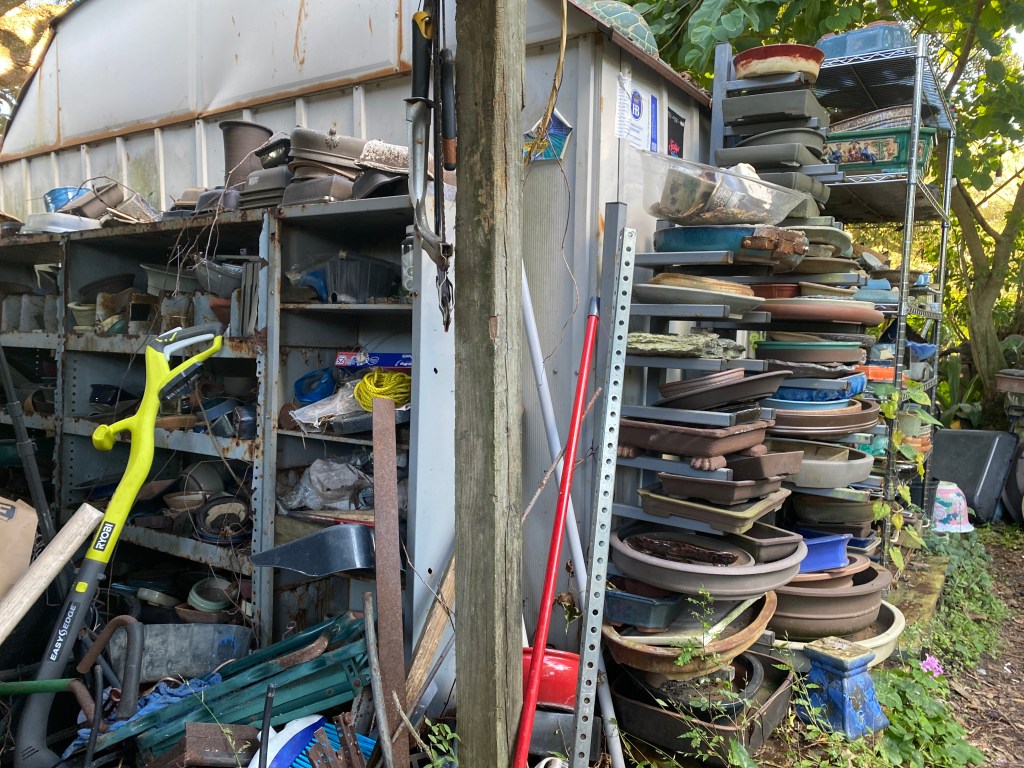
But we aren’t here to talk about that.
Or are we?
I recently attended the Multi-Club Auction hosted by the Bonsai Society of Brevard (BSOB, which could be interpreted as the Bonsai SOB’s, but I digress), and I was mostly looking for pots.
I got several nice ones,
a Jim Smith,

a Taiko Earth,

and a Clif Potberg…

And I bid on a tree in a sweet Rob Kempinski pot as well. And won! (Not for a “dollah” unfortunately)

A willow leaf ficus, it’s slowed down its growth for the year, but I might get some after the work I’m about to do. Looks like it had a bout with the fungus that affects them here in the Florida rainy season. I’m not sure of the species of fungus (or if it’s even a fungus, it could be bacterial). I had asked my Fl. Dept of Ag to culture it but they couldn’t get it to grow. It presents with the leaves just getting brown and it dying off. You’ll lose fine branching if you’re not careful. Part of the problem is culture, if you have too dense a canopy, in the rainy season, the disease takes hold. I try to thin out and defoliate mid summer to try to combat it. Here’s some damage on another tree for reference:

I was able to contain it on one branch.
On today’s tree, there is some of this damage, but I’m not worried about it. I’ll be able to control it come next summer with a combo of fungicide application and judicious pruning when it’s needed. Hopefully.

Today, I’m going to Slip Pot the ficus into a larger pot, clean the trunk, cut it back some, lower the first branch on the right with a wedge cut, and wire some branches down.
Here’s the pot I wanted, BTW. I got the whole thing for about $100, what I would’ve paid just for the pot, so the tree was basically free. This is an example of why you shouldn’t skip club auctions, you can build your collection with mature trees for cheap money.

On older willow leaf specimens, the trunk color will start to turn a deep red/purple.

To bring that out, I’ll use some regular old h2o2, full strength.

What you’d get at any pharmacy or store. And a trusty nylon brush. I usually recommend using your spouses or significant others toothbrushes, but my wife read that in a previous post and locks hers away now. So I’ll be using this one, easily found in hardware stores (but not so funny a story to tell).

Dip it into the hydrogen peroxide and gently scrub the trunk. It’ll kill any mold, fungus, lichen, bacteria, whatever, on the trunk, and remove some of the grayish oxidation from exposure. The h2o2 won’t hurt the tree, as it becomes inert water after it comes into contact with catalase (the method of action is a simple one: most living cells contain an enzyme called catalase. When the h2o2 encounters it, say in a bacteria or fungus cell, the catalytic conversion breaks the h2o2 into water and oxygen -h2o and o2 respectively-and that’s why you get the bubbling).

Ergo, any liquid that reaches the soil is plain old water, so it doesn’t hurt the roots.

I’ll let that sit and do it’s work as I turn my gaze to the pruning.
As you can see, there are a lot of unneeded branches, i.e. branching of three or more, those going up or down, dead twigs etc.

Let’s do a mild defoliation so I can see the branching better, and start editing out some branches.

How’s that?
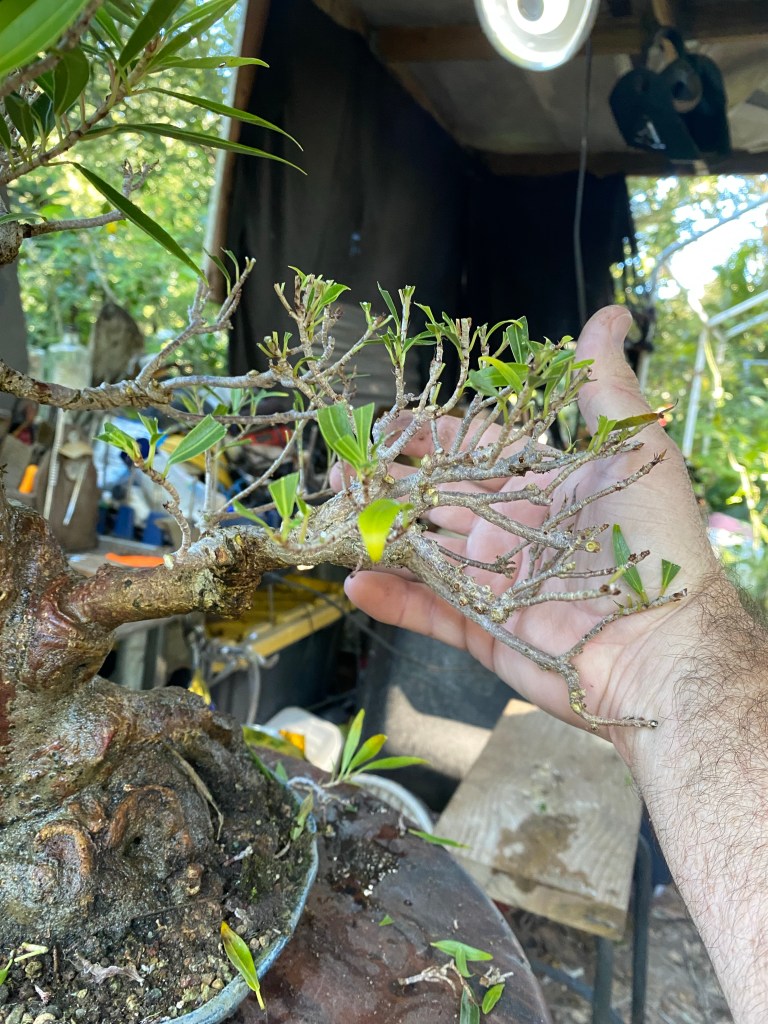
There’ll be some wiring a little later in the program.
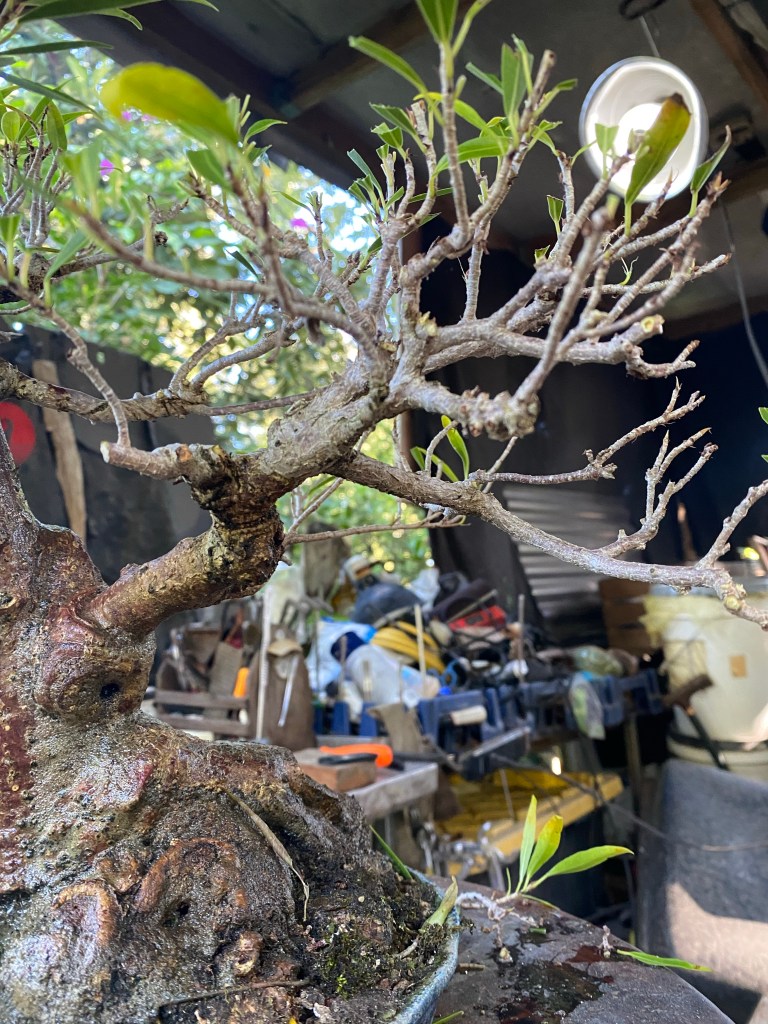
Next step will be some sculpting. Sharpen the knife or whatever implements of destruction you prefer….
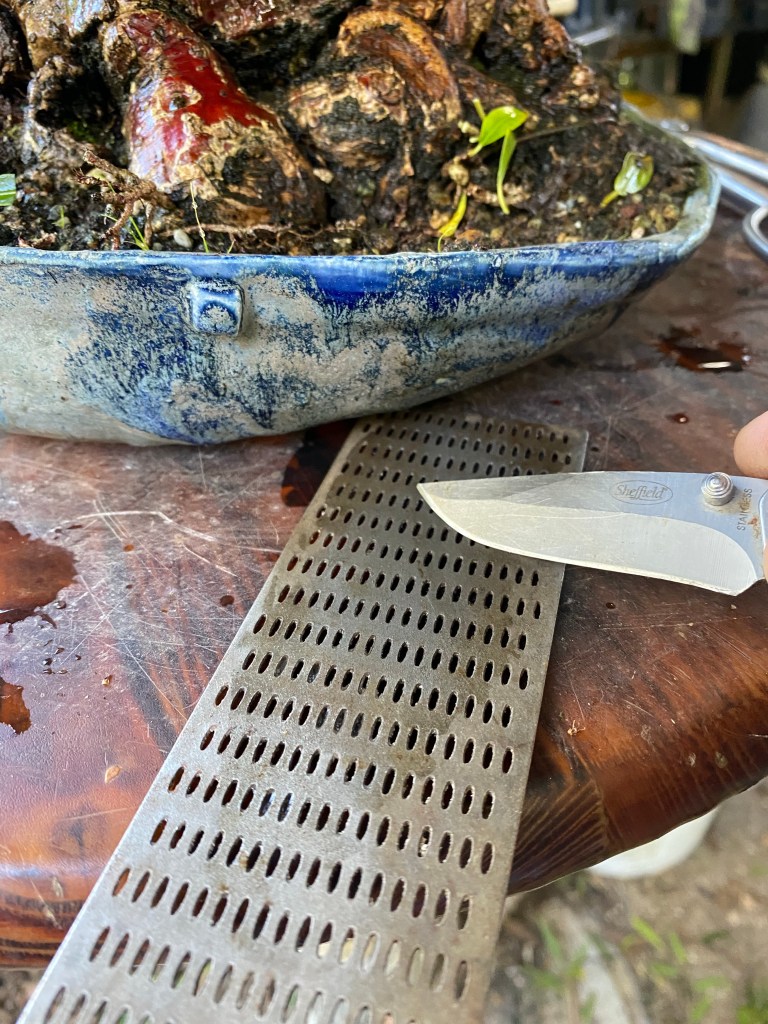
Identify some ugly bulging and scarring.
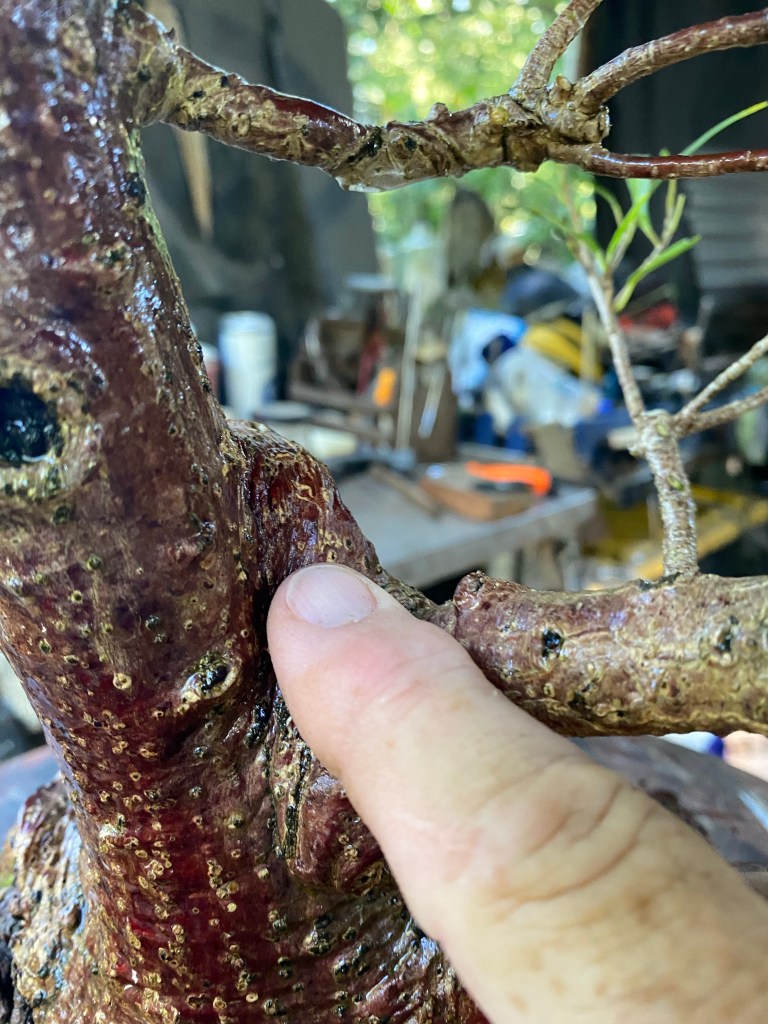
And whittle away.

This works on willow leaf spectacularly. A little more smoothing…

Ficus heal in ways that create knobby scars. Sometimes that’s a good thing (chicks dig scars, after all) but sometimes you want the eye to move better along the trunk line (that’s the “art” aspect of bonsai composition).

Next step, let’s get it out of the pot.
A little snip…

And it pulls right out (from a man with four children, there’s a joke there….).

Voila! I used to write it as “viola” but only one person got the joke. It was sad, really, like the sound of the worlds smallest violin.
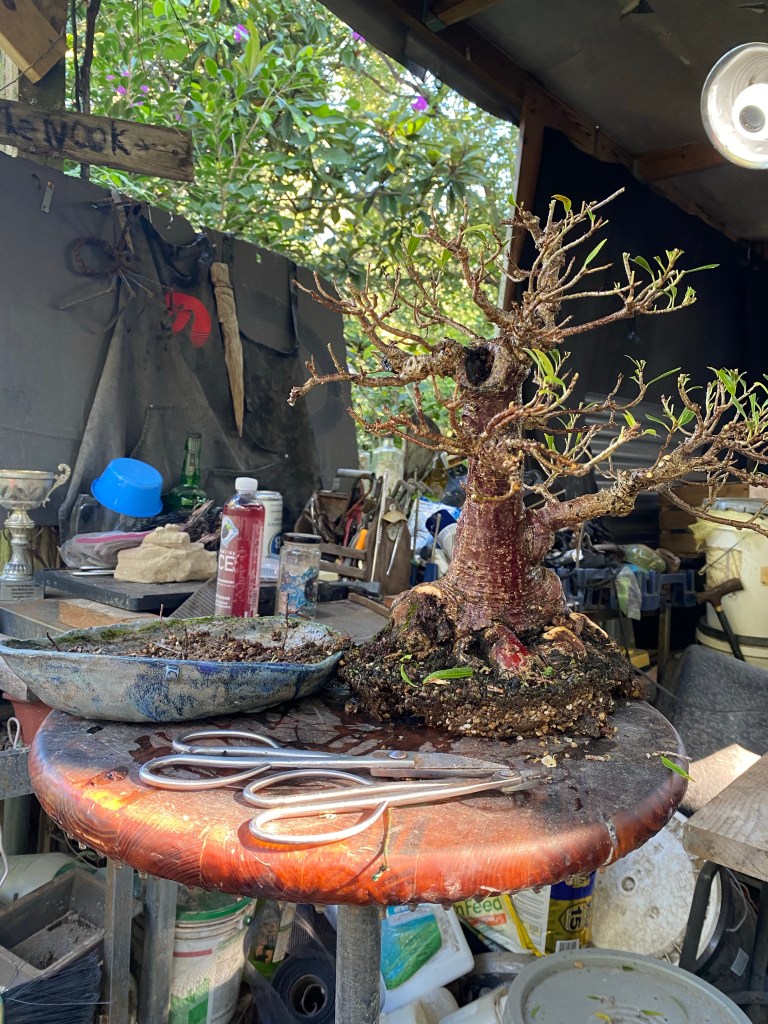
The “new” pot. Just a bigger Chinese production container. It’ll get a better one in a few years.
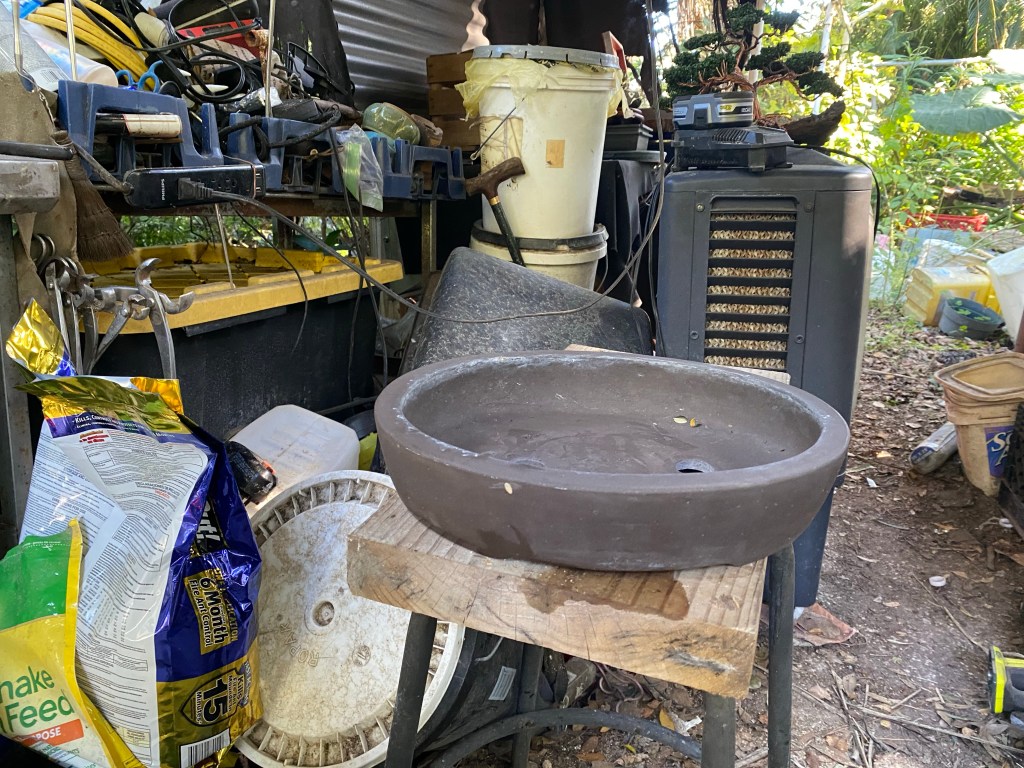
Old pot vs. new pot. Deeper, wider, better for growth and drainage (part of that “culture” I talked about earlier).

My Soil mix. Missing pumice as it’s hard to find nowadays.

And into the new pot.

Now for the “advanced” technique

I’ve disinfected the branch and my saw, with the hydrogen peroxide, as one should.

You’ll notice the thin blade with sharp teeth.
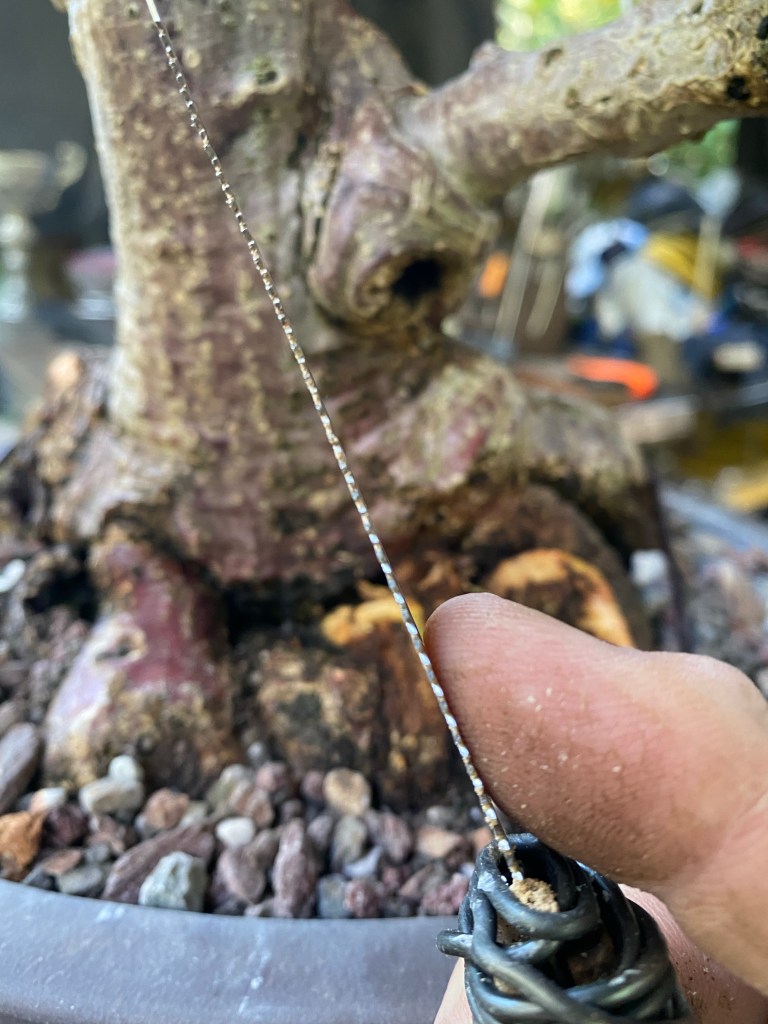
I create a loop of wire I’ll use to pull the branch down after the cuts are made.
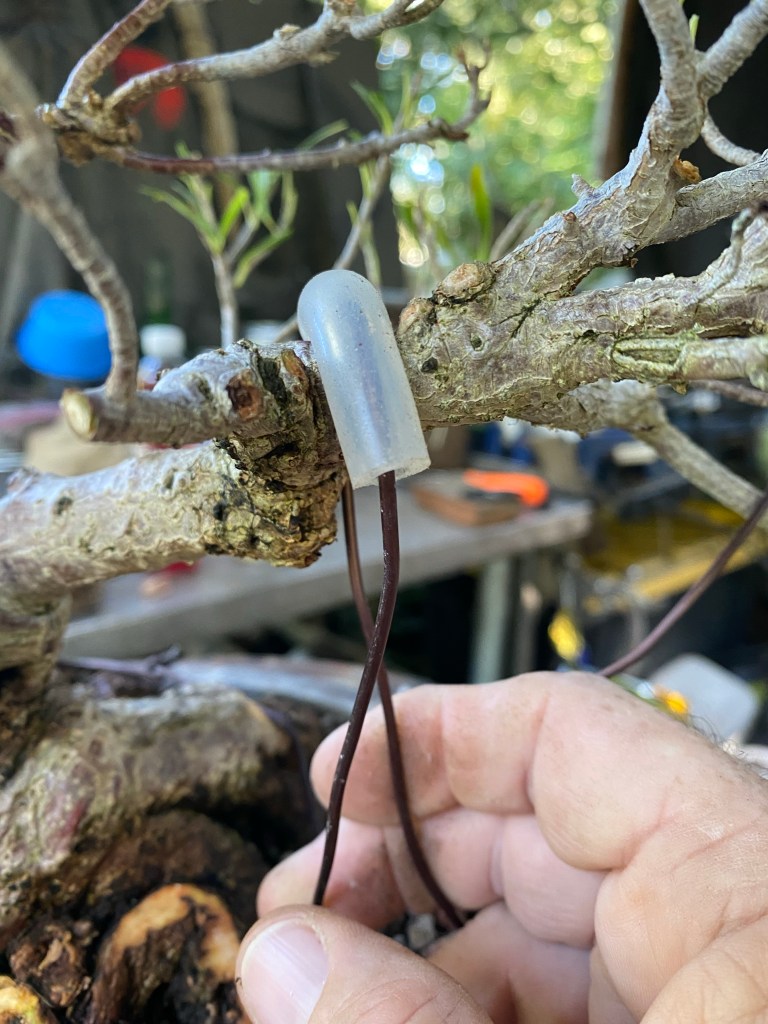
Make the cut. Sometimes you need to cut almost 90% through to get the branch to move, this time I only cut about 75%.
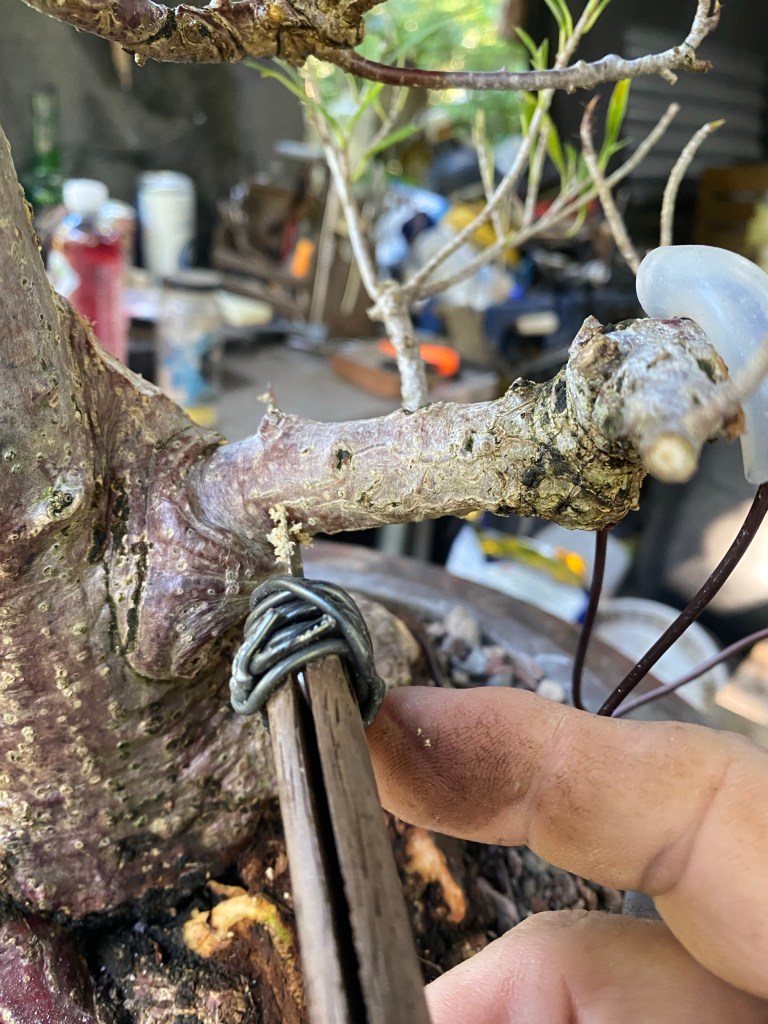
Push the cut down together (a wedge cut is a misnomer. This was just a straight cut, as I’m only moving the branch down a few degrees. But sometimes you need to make a wedge).
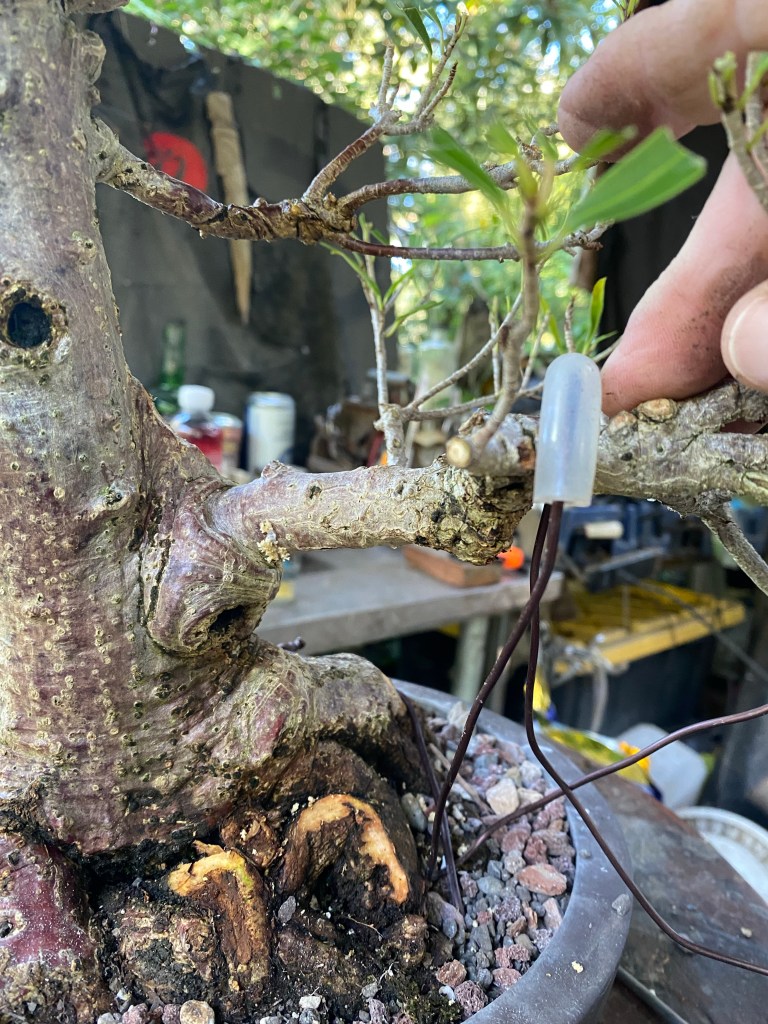
Tie the bottom of the wire loop, while holding the branch down.
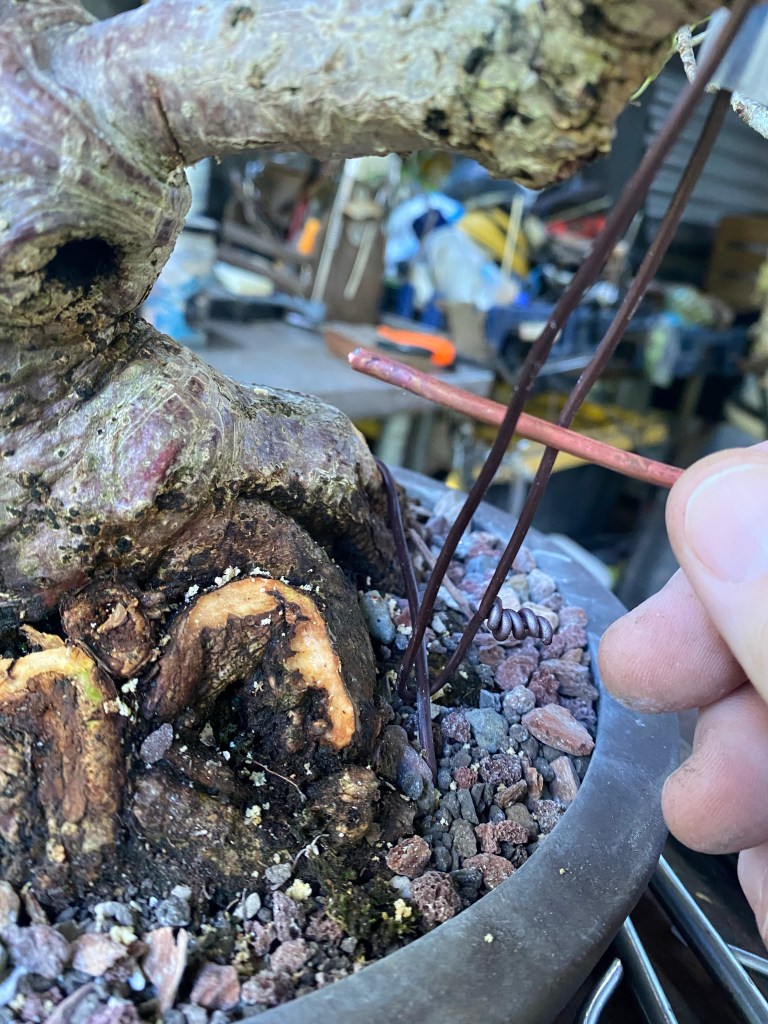
Get a stiff piece of wire and begin the turn-buckling.

You’ll notice in my tie down wiring I don’t usually use the turnbuckle technique. I tend to just hold the branch down and use a guy wire. In this case, we do it for two reasons, first, it looks cool and it will impress your friends, but, secondly, and more importantly, we want full pressure on the cut, so that it heals faster. Lining up the cambium and the pressure providing that seal or something technical like that.
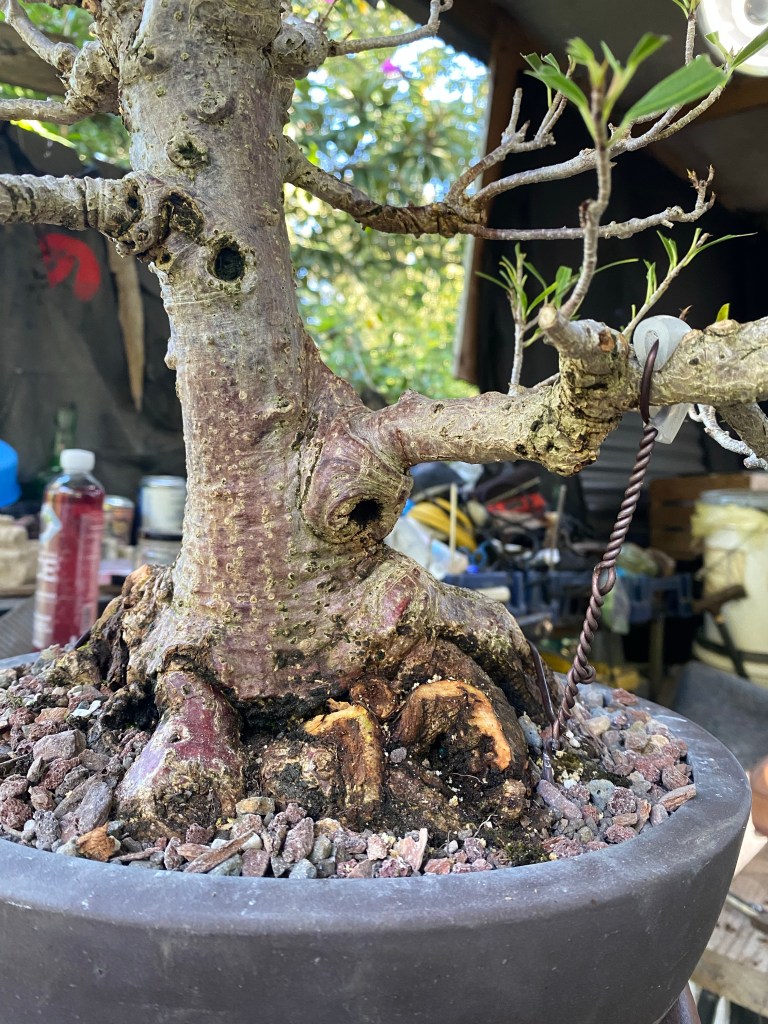
Now to some wiring. And a little more pruning, methinks (ergo….methinks….who do I think I am, Shakespeare? Next thing I’ll be making up words. Like hyperbolot: one who uses hyperbole a million times a day. Like your mom…).

Wired out.
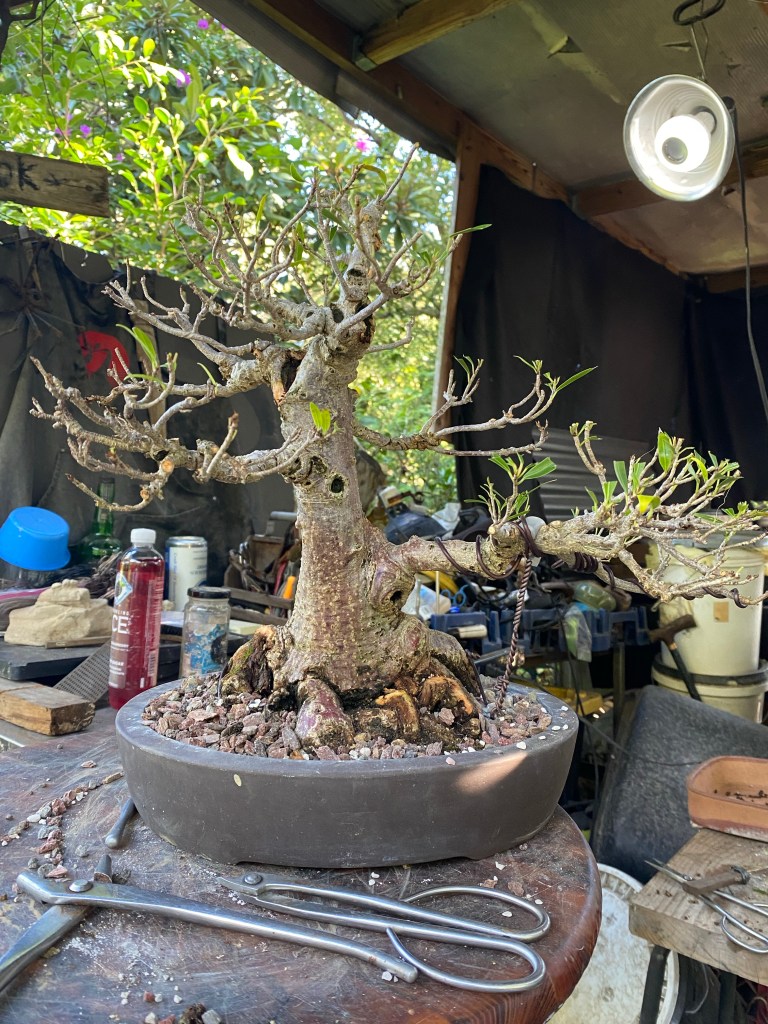
And cut back. The top had some reverse taper near the apex, so I cut it and need to regrow a new one.
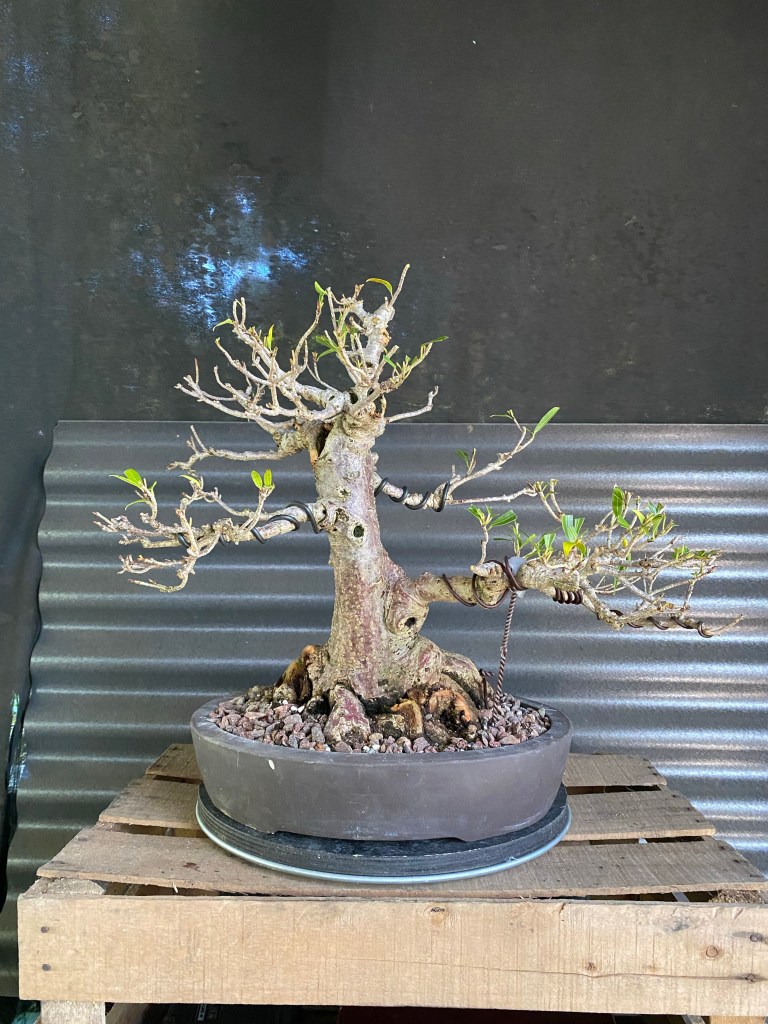
I know, doesn’t look like much, but it will. in time. Not too long really, a few years, but the work done today will make it go that much faster.
Bonsai is about applying consistent techniques at the correct time in a trees growing seasons and level of development.
Anyway, remember that it was the pot I was really after, the tree is gravy (on a side note, my Thanksgiving dinner, at my wife’s uncle this year, did not include gravy. I mean, really, no gravy. I would’ve been lost if it weren’t for the bourbon….)
The pot!
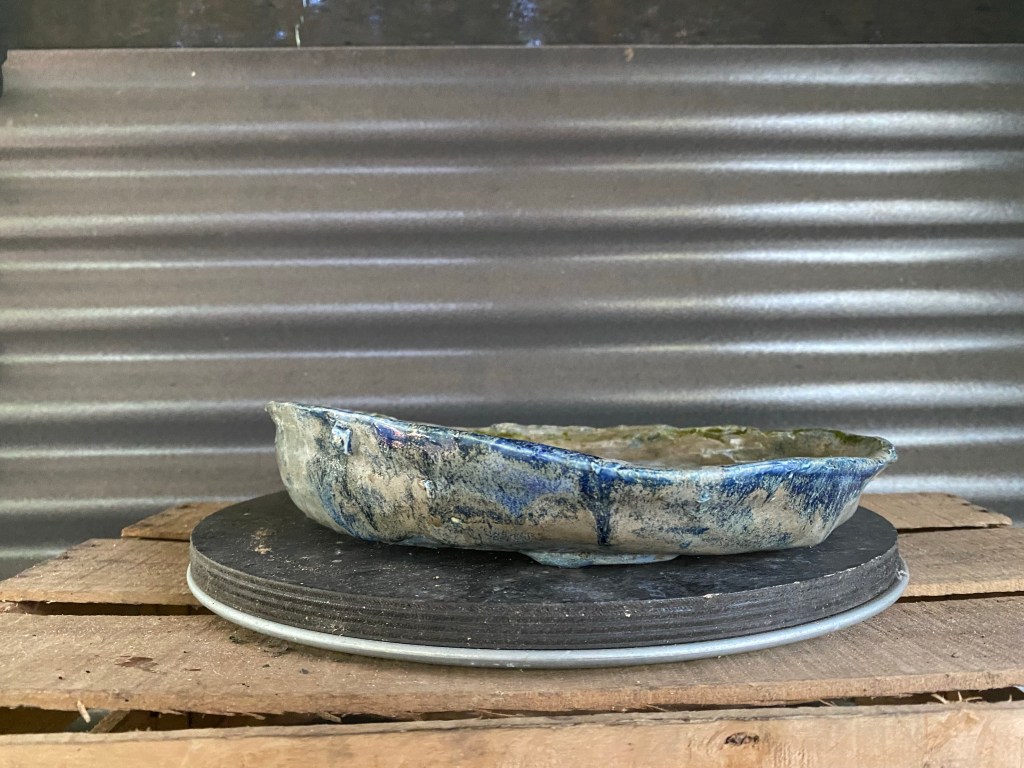
Sweet, ain’t it?

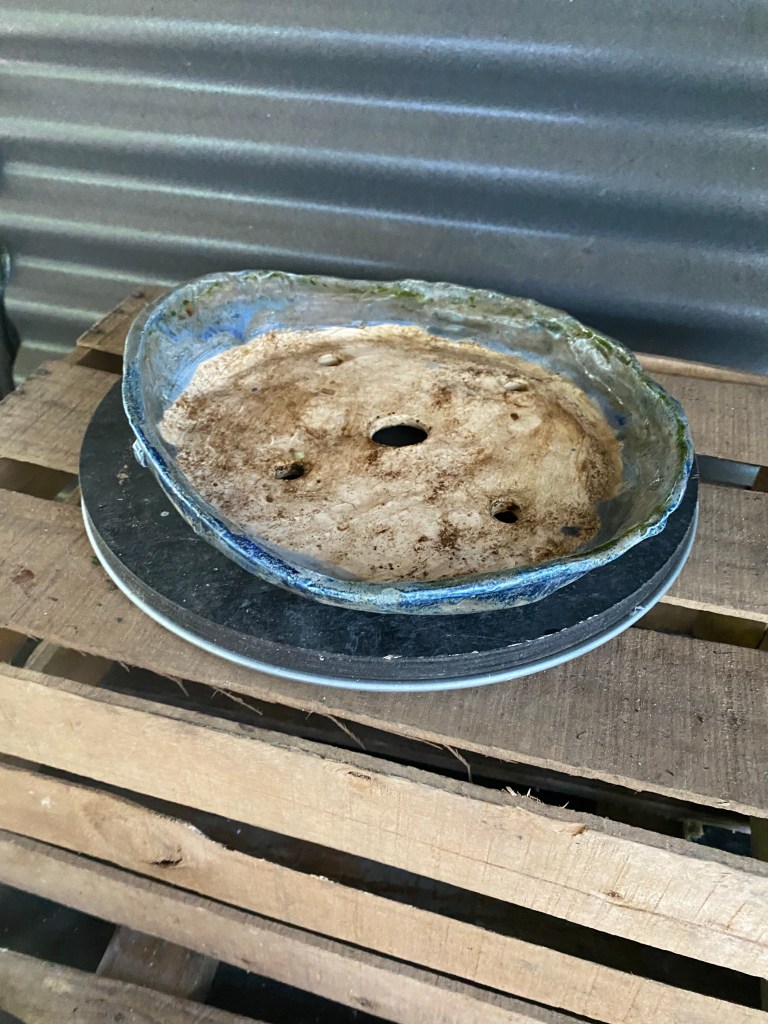
Rob likes to name things, and his pots aren’t excluded. It says “The Eleventh Hour”

When I find a good tree for the pot I’ll post it on my Instagram. And I’ll update the tree in the spring.
It’s hyPerbole…must have been a typo. Fabulous pot
LikeLike
Doh! You’re right. Fixed, thank you
LikeLike
Hey Adam, when doing a wedge cut, does the cambium actually fuse back together? I’ve tried to get them to do that in the past with a break (or two), without much success. Any tips on salvaging a branch you really didn’t want to snap?
LikeLike
The trick to getting a break or the wedge, in this case, is that pressure. When the wound heals, it often pushes away from itself and never closes. The pressure holds it in place and will cause it to inosculate, or self graft
LikeLike
Awesome. The one I did most recently, I took a piece of wire and used it like a twist tie, applying the pressure. Fingers crossed……
LikeLike
Reblogged this on Wolf's Birding and Bonsai Blog.
LikeLike